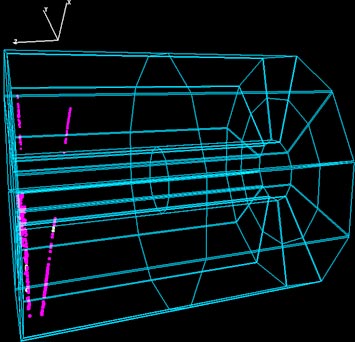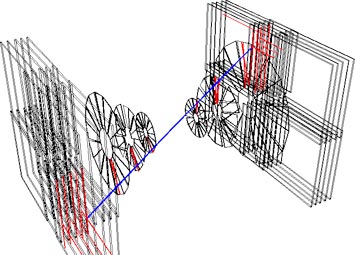Calibrators from Deep Space Tune High-Tech Earthbound Physics Experiments
Researchers use high-energy extragalactic particles to align and calibrate state-of-the-art detectors at Brookhaven Lab's Relativistic Heavy Ion Collider (RHIC)
July 31, 2013

Hold out your hand: Look closely. If you're outside on a sunny day, you might see dust motes and pollen dance in the air, perhaps landing on your skin, and bright rays of sunlight peek between your fingers. To the naked eye, your skin provides a barrier between your body and these exterior elements. The light refracts around your palm, not through it.
But microscopically, the air is filled with particles that have the ability to traverse solid matter. Sunlight is actually composed of tiny “packets,” or quanta, of light called photons. Most structures built of wood or metal block the light’s rays, but photons can stream through transparent materials and penetrate our skin to tan or burn us.
Also speeding through nearly everything are trillions of mysterious particles commonly known as “cosmic rays.” These supercharged subatomic particles originate from deep space—probably from supernovae explosions and possibly outside the Milky Way galaxy. Some travel at nearly the speed of light and can easily pass through almost everything you see: your hand, the building behind you, the Earth’s crust—and even the massive detectors of giant physics experiments like the Relativistic Heavy Ion Collider (RHIC) at Brookhaven National Laboratory.
RHIC physicists use tracks of cosmic rays traversing the PHENIX (top) and STAR (bottom) experiments to calibrate and align detector components to ensure the accuracy of experimental data taken during particle collisions. enlarge
enlarge
That turns out to be a boon for RHIC physicists, who study subatomic smashups of gold ions inside RHIC’s detectors to get clues about what the early universe was like. They’ve come up with ways to use the far-flung supernovae remnants to calibrate their detectors to be sure the data from their experimental particle collisions is recorded as precisely and accurately as possible.
"Before the first ion beam is accelerated, we take data with the cosmic rays to study internal detector behavior, and to keep data acquisition buzzing," said Hubert van Hecke, a physicist at RHIC’s PHENIX detector.
Because cosmic rays are readily available, easy to identify, abundant, and free, they're the perfect micro-tools for calibrating and aligning RHIC’s cutting-edge detection instruments. The collider isn't active all year round, and often a period of dormancy leaves these sensitive detecting tools out of sync—like the keys of a piano left unplayed for several months. A piano tuner uses an external source that provides a note in perfect pitch to calibrate the keys. The detectors at RHIC require a similar alignment process when they're first turned on. The physicists use the predictable, consistent radiation patterns of cosmic rays coming in from space as the “perfect pitch” for “tuning” the detectors.
In the weeks before accelerating gold ions, the researchers activate a special trigger within the PHENIX detector to recognize those patterns. Since the high-energy cosmic rays pass right through the wall of dense concrete that houses the experiment, and the 8-inch-thick iron casing around the detector, they’re easy to distinguish from other particles. Researchers also know that cosmics typically arrive in clean, straight lines, making them ideal candidates for calibration and alignment between the different systems within the detector.
"Cosmic rays [allow] us to align the experiment and determine the accuracy of the detector."
— PHENIX physicist Hubert van Hecke
"We have a lot of components and systems that constantly 'talk' to each other, and they need to be in alignment,” said van Hecke. “For example, we have a detector on the north wall that is far away from the detector on the south wall. Cosmic rays are the only particles that traverse both detectors simultaneously, allowing us to align the experiment and determine the accuracy of the detector."
This simultaneity lets researchers exploit the consistency of the cosmic rays' momentum and velocity: When the system components are functioning perfectly, each should record identical measurements for any cosmic ray passing through and recognized by the activated trigger. If these measurements are off, the data the detector collects could be compromised. So researchers tweak the instruments until their readings match.
"The cosmic rays can be used as a kind of ‘standard candle,’” said Ralph-Christian Seidl, a PHENIX researcher from the University of Illinois, referring to the process of using supernovae or stars of known luminosity to measure astronomical distances. “We know they are always there and we can use them to understand our detector better because we know their characteristics so well. We see about a hundred cosmic ray events per second, and since these events are clean and easy to identify, they can be used to make sure both detectors are recording the same information."
STAR, the other large experiment at RHIC, also uses cosmic rays for detector calibration—sometimes even during an experimental run, interspersed with taking data from collisions created in the collider, said Jamie Dunlop, a member of the STAR collaboration.
“One thing we do is to match the momentum of tracks that go from the top to the bottom of the time projection chamber,” he said, referring to the house-size, gas-filled solenoid magnet that acts as a giant 3-D digital camera to capture the tracks of particles emerging from RHIC collisions. “In the case of cosmic rays, these look like two tracks, but they are really one. By measuring the momentum of those particles twice and looking at the difference between the two measurements, you can see how accurate the momentum measurements of the detector are. This is extremely useful, for example, as a gauge for how well we measure the charge sign of certain particles in RHIC collisions.”
It's a simple and free technique that taps into the deep history of space, yet provides contemporary and pragmatic results—a sublime example of how modern technology utilizes all that is strange and wonderful about the universe, even as scientists push experimental frontiers to understand its makeup and history more profoundly than ever before.
2013-3809 | INT/EXT | Newsroom










